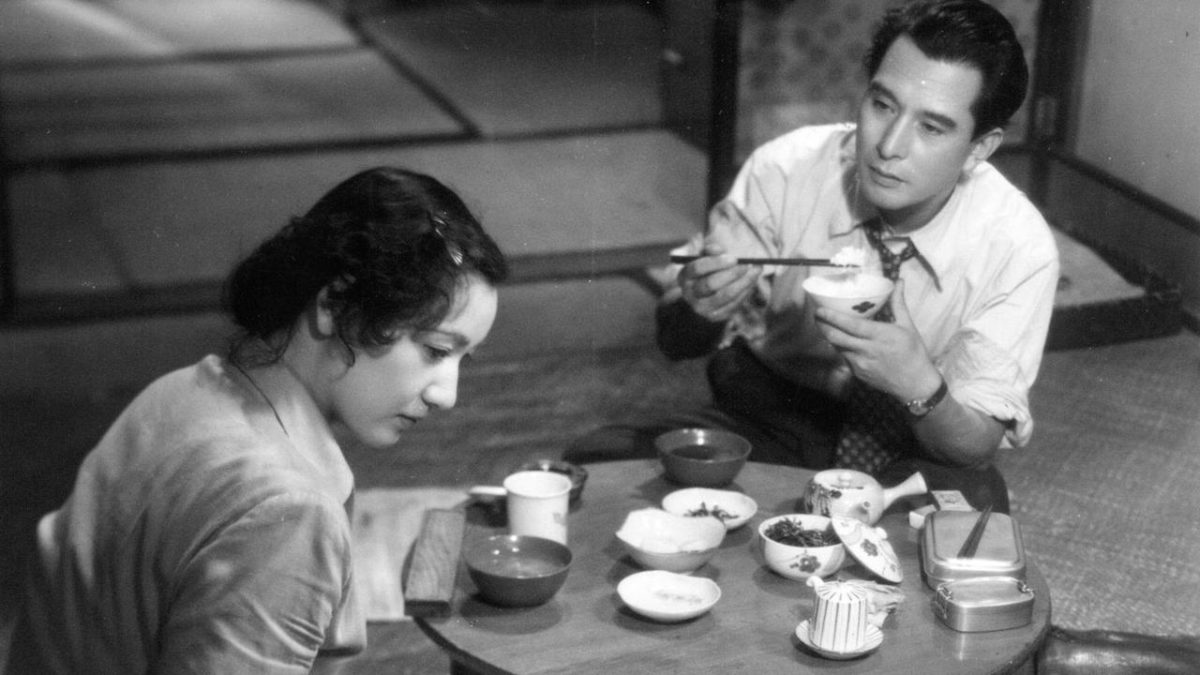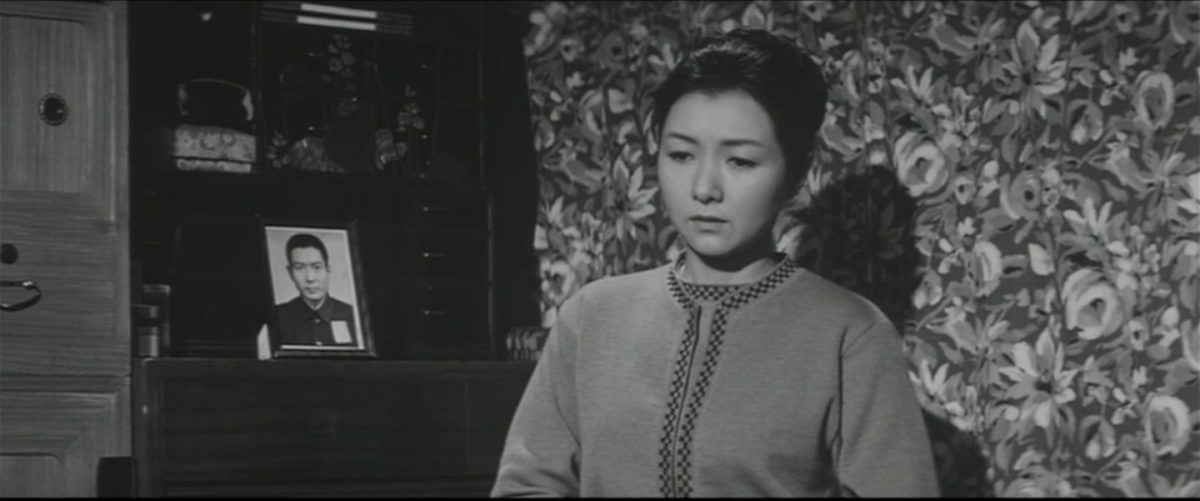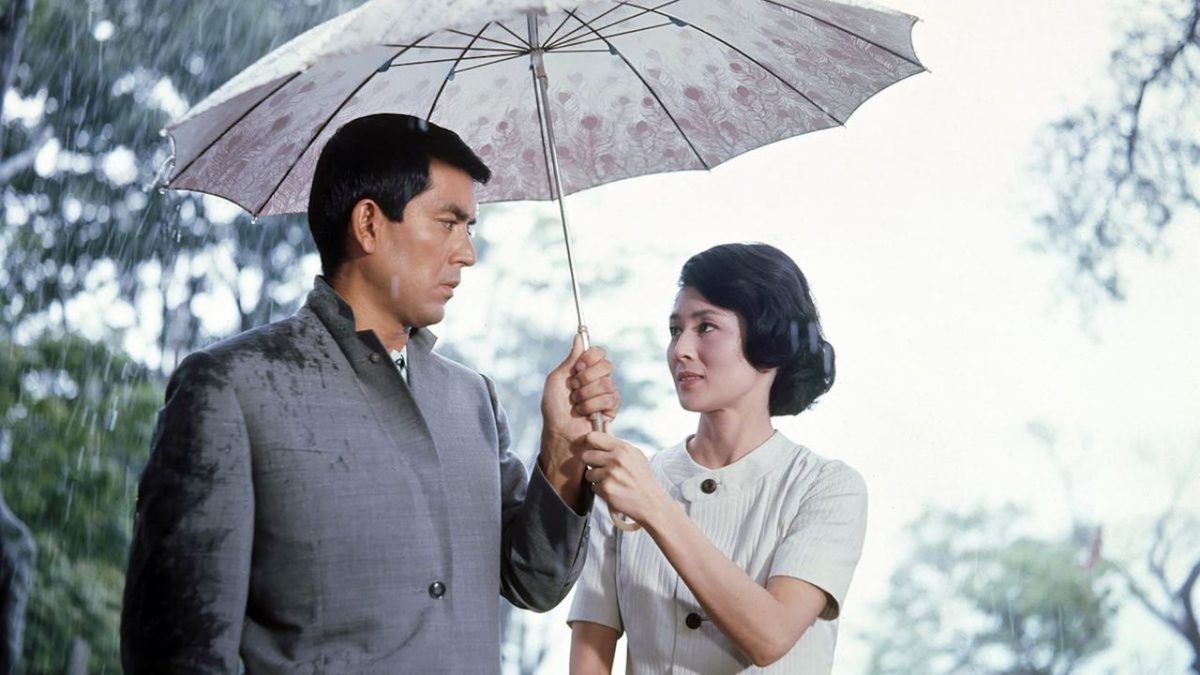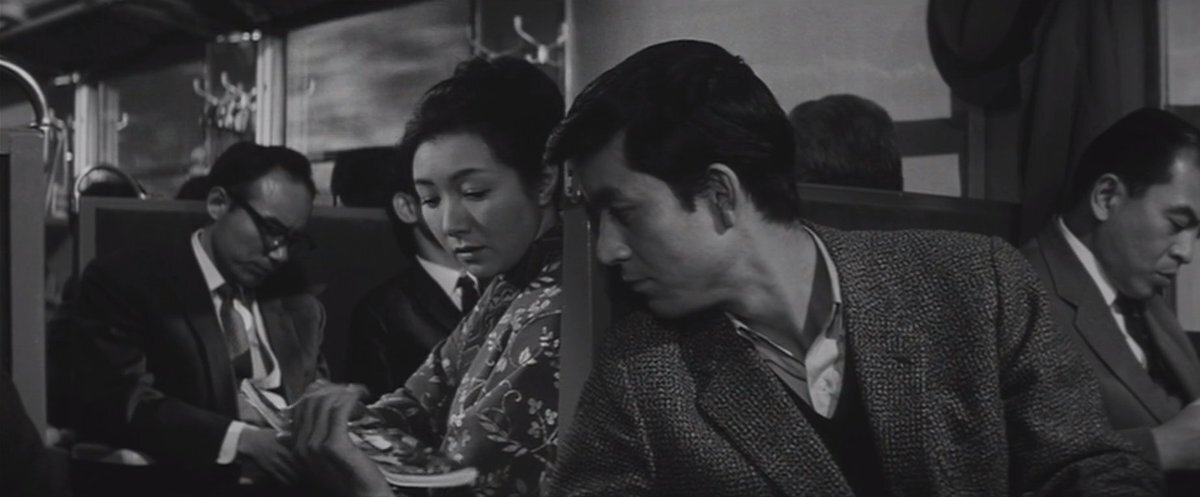In Ozu Yasujirō’s final film, 1962’s An Autumn Afternoon, an elderly widower runs into a former subordinate from his navy days by pure happenstance, and the two decide to have a drink together. As an old marching song wafts from the bar’s radio, the younger man—in one of the director’s most explicit references to WWII—asks the older one, “If Japan had won the war, how would things be?” The two conjure an imagined scenario together, one where they’re drinking at a bar in New York City, and the Americans are the ones who remained unwillingly tethered to their homeland. In signature Ozu fashion, these lines come forth with a disarming levity, which makes the unequivocal sadness surrounding them all the more rupturing, perpetuating a pall of dashed opportunity over the rest of the film, while diagnosing a national sense of displacement.
In Naruse Mikio’s own final film Scattered Clouds (1967), a young businessman and his wife, Yumiko (Tsukasa Yoko) are soon to leave for Washington, D.C., but on that very same day of learning of his expatriating promotion, the husband is struck and killed by a car, driven by Mishima (Kayama Yūzō). Thus, his wife is effectively left to drift around varying Japan environs, some similarly defined by transience (she spends a significant amount of time at a family owned inn), and like many a Naruse protagonist, comes to embody that stray sentiment of Ozu’s film: thoughts of a move elsewhere, not just necessarily abroad, that manifest themselves through numerous channels. Like Ozu’s film, Naruse’s characters’ own dislocation is inextricable from the war, but such a palpable waywardness can be gleaned from the most banal of circumstances, that still manage to carry as much weight as a cross-continental move westward would, such as moving house, or perhaps a change in employment.
Naruse’s films maintain a deceitful placidity across even the most discombobulating events, so much so that less discerning critics have contributed to the unwelcome proliferation of Ozu comparisons. The former expands past the self-enclosed character orbits that the latter constructs for each film, sublimating a sense of tragic displacement into a patiently organic narrative development that is inextricable from the most mundane of activities. The crux of many a Naruse film is the destabilizing event that can be disarmingly quotidian or absolutely sideswiping (such as the car accident in Scattered Clouds), and this established spectrum makes these moments of upend a familiar device, though still impossible to predict in their specifics of time and place. If this is a well-tread directorial device on the part of Naruse, it is one of scintillating mutability as well.
It’s commonplace to divide Naruse’s career into a tripartite structure of before, during and after the war, which can be broken down further into the prevailing critical shorthand of mapping quality, a method that filmmaker and writer Dan Sallitt describes as “not totally inaccurate.” The goodwill Naruse had amassed through his silent period—which yielded the lauded No Blood Relation (1932) and Every-Night Dreams (1933)—dissipated under the strictures of a wartime government, and his work was no less hampered by the subsequent allied occupation. Then 1951’s Ginza Cosmetics brought upon a boon, kicking off a run of films through the early to mid ‘50s that are often cited as the director’s best, although this remarkable consistency runs all the way through Scattered Clouds, which belongs to an unfortunately more neglected pool of projects that came near the end of his career.
It’s the postwar, post-occupation films that benefit from a confluence of preoccupations, both formal and thematic. This period proved to be fruitful collaboratively, as Naruse built something of a regular network of numerous writers, all of whom were absorbed seamlessly into the director’s own singular mise-en-scène. Writer Hayashi Fumiko, whose own novels were adapted into Repast (1951), 1954’s Late Chrysanthemum and 1955’s Floating Clouds; Ide Toshirō, a co-writer on Repast, and the screenwriter of 1966’s The Stranger Within a Woman; Kikushima Ryuzo, a regular collaborator of Kurosawa Akira’s and the writer/producer of 1960’s When a Woman Ascends the Stairs; and Yamada Nobuo (notably utilized by Kurahara Koreyoshi and Shinoda Masashiro), responsible for Scattered Clouds.
Besides a brief flashback to Japan’s occupation of Indochina during WWII in Floating Clouds however, many Naruse films of this time don’t move from beyond the country’s borders. National restlessness is integrated as narrative scaffolding, a deciding force that provides an emotional groundwork in which such uneasy sentiments are telegraphed through offhand gestures, references and general unsureness. The plot of a Naruse film is inextricable from the local plane from which it occurs, but its thesis consistently sets its sights beyond. In 1961’s The Approach of Autumn, eleven-year-old Hideo (Kenzaburo Osawa) must reckon with the fact that he has been abandoned by his mother, left in the care of his Tokyo relatives. Such is the film’s ground-level conceit, but with the introduction of the nine-year-old Junko (Futaba Ichiki)—daughter of the manager of the hotel Hideo’s mother absconded from with a male patron—the film’s dialogue begins to expand beyond the immediate milieu, clinched by a growing fascination with the ocean.
The significance of the ocean resides on the peripheries of many of Naruse’s films, playing the part of both a binding capitalist model and a transportive opportunity: in 1964’s Yearning, a secondary player at the central family’s grocery store imagines escaping onto the water, but his own fantasies are grounded by the inescapable fact that his desired worldly travel will come solely at the behest of a job. Often this pining to be elsewhere is filtered through—or obstructed by—varying layers of time and space, of social and economic mores that bely even the most effervescent of daydreams. Returning to The Approach of Autumn, Hideo longs to see the ocean, confessing to Junko that the closest he’s come to it is through its mention on the radio and images on television. Being that his mother is busy with work at the hotel, and that the two children are much too young to venture on their own (at least initially), they settle for the view from an observation deck, the landscape of Tokyo still dominating much of the black-and-white Tohoscope, the ocean otherwise an unremarkable blur perched at the top of the screen.
There’s not always as realized a physical, beckoning entity as the ocean; in two of the director’s films from 1951, Ginza Cosmetics and Repast, the significance of The Approach of Autumn’s geographical barriers are otherwise present in interpersonal relationships. Where Hideo’s mother’s decision to leave occurs offscreen, Ginza Cosmetics and Repast are themselves governed by these adult anxieties that have the potential to displace their protagonists, whether they like it or not. The former—a largely plotless affair—is one of Naruse’s most formally kinetic films, attaching florid technique to a day-to-day reckoning with the precarious economic standing of a Ginza Bar, which slowly unspools to call attention to even more diverging dramatic strands. That Naruse opts for the figure of the young son—almost always glimpsed in a flurry of movement—to deliver the interstitial transitions speaks to this preoccupation with disrupting preconceptions of location, captured here in an embryonic stage.

Repast flattens the animated energy of Ginza Cosmetics, while still preserving the kinds of relationships that otherwise dictated that earlier film’s unpredictable flow, its narrative structure more handily bifurcated with its particular elements of displacement. The opening section lays bare the drudgery of a married woman’s routine, with former ‘Tokyoite’ Michiyo (Hara Setsuko) sequestered in Osaka with a domestic existence at behest of her relatively genial, though mostly oblivious husband’s job. Their own disconnect is exacerbated by the arrival of the latter’s niece, whose own running away from home and childlike besottedness with Michiyo’s husband proves to be just the ejecting force that pushes Michiyo to head back for Tokyo. In one of Naruse’s most graceful tracking shots, Michiyo—while in Tokyo—is framed by an overpassing train and an infinitely stretching riverbank vista, a further suggestion of unharnessed possibility, as she’s only returned to somewhere familiar. This visual realization of a continued displacement occurs in tandem with conversations had in the second half of the film: there’s still familial bickering and unease over matters of unemployment.

Two of Naruse’s most widely available and beloved films—Floating Clouds and Yearning—further explore the locale-shift at the center of Repast, to more tragic, even fatalistic, extremes. The former especially, in its elliptically detailed doomed romance, is perhaps the Naruse film that most fulfills Kurosawa’s oft-cited description of the director’s working method:
Naruse’s method consists of building one very brief shot on top of the other, but when you look at them all spliced together in the final film, they give the impression of a single long take. The flow is so magnificent that the splices are invisible. This flow of short shots looks calm and ordinary at first glance then reveals itself to be like a deep river with a quiet surface disguising a fast-raging current underneath. The sureness of his hand in this was without comparison.
A loose assemblage of dalliances and decoupling between Tomioka (Mori Masayuki) and Yukiko (Takamine Hideko), Floating Clouds seamlessly provides the backdrop of Japan’s own postwar development for these two displaced individuals. It’s a fidgety film, its chilly, greyscale compositions only barely veiling the inevitable trajectory of the central relationship. The specter of WWII remains firmly ingrained not just in Japan—the presence of an American G.I. hints at the subsequent occupation—but in the shared feelings between Tomioka and Yukiko. In one of the film’s many pivots, a sudden flashback reveals their meeting in Indochina, an evocatively lit portrait of colonialism in miniature that recalls Jacque Tourneur’s I Walked with a Zombie (1943). The war is responsible for bringing them together, and also what’s sent them spinning apart, Yukiko never being able to gain solid footing spilling over into the detached Tomioka’s own life (he has a wife to return to, after all). An innumerable amount of tiered relocations, both emotional and physical (jobs, homes, affairs, etc.) commences, a years-long, haphazard mutual chase with a chilling implication that begins to mount in the final act: that the only chance at stillness is death.

Yearning possesses even more unimpeachable acknowledgements of the war, the protagonist Reiko (Takamine) herself being a war-widow. There is a fraught undercurrent of monetary worry, as is often the case with Naruse’s grocery stores, around which much of Yearning revolves. Reiko must contemplate her place in her husband’s family life, who owns the store she works at, if she is a necessary fixture, or merely a desultory burden. It’s in the film’s first half where Naruse’s themes of dislocation are brought forth on a purely psychological plane, Reiko’s own unsureness compounded by the fact that she’s been effectively marooned by the war. A proclamation of love by her husband’s layabout-cum-proactive younger brother Koji (Kayama Yūzō) only exacerbates her own unbelonging. Reiko makes the decision to return home (not unlike Michiyo in Repast) and gets tangled with her own amorous desires when Koji accompanies her on her multi-day train trip. This breathlessly edited traveling sequence consists of exterior shots of the changing landscapes offset by a palpable “will they or won’t they” tension emanating from the two characters as they share sandwiches and steal glances, an initially lighter example of Floating Clouds own relationship, though still similarly catapulted like a shot-put across Japan. That the ending brings forth a self-inflicted alteration of that earlier film’s closing tragedy only further clinches the ruthless, “fast-raging current” present in Naruse’s work that Kurosawa spoke of.

That Naruse broached the subject of domestic displacement while apace of his startlingly prolific and consistent output then positions Scattered Clouds not as a culmination, but another document of the director further burrowing into his well tread thematic raison d’etre (his death only coming two years later, in 1969, suggests that the director’s workflow would end abruptly rather than bow out with a knowing swan song, however appropriate the resulting film). Elements from both Floating Clouds and Yearning are cannily repurposed, augmenting the near ping-ponging structure of the former with the crystallized thematic visualization of the train sequence of the latter. The destabilizing event of the deadly car accident in the beginning of the film sends Yumiko and Mishima careening (this being Naruse, this violent displacement is dressed up in the agreeable guises of commonplace matters of employment, familial commitment, recovery and the like), fitfully reunited by the countryside inn owned by Yumiko’s family. The inn itself acts as something like a purgatorial emotional realm in Scattered Cloud’s later acts—Yumiko was just on the cusp of starting a new life with her husband in the United States, before being unwillingly stranded, and Mishima is falling further down the corporate ladder, which will soon push him all the way out to Lahore, Pakistan.
A general malaise penetrates both lives, and their shared trauma—regardless of the circumstances—makes each the other’s most personable lifeline as they navigate the occasionally demeaning responsibilities of their jobs. The two must reckon with the continued events that push them together, such as a missed bus, or a rainstorm that lays Mishima out with a fever (Yumiko acts as his caregiver). The fumbling gait of their romance is overwhelmingly tense, punctuated with strained dates and even awkward proclamations of love. And like Floating Clouds and Yearning before it, Scattered Clouds is laden with physical movement that is rendered tragically ineffective by the close. However, death only exists at the peripheries of this film, the memories of the car accident manifest in the viewing of another vehicular crash during a shared cab ride. Then, when Yumiko and Mishima arrive at their destination, they’re greeted by a man being rushed out on a stretcher into an ambulance. Like its predecessors, Scattered Clouds exists in a postwar Japan heavy with emotional, physical and social limitations that instill thoughts of some sort of escape, but which in reality only evince a perpetual, hemmed-in displacement.
All these mentioned films exist in this paradoxical limbo. Naruse’s characters are inundated with restlessness, but are still insolubly attached to their homeland by the effects of the war. From this fertile dichotomy, equally fruitful modes of melodrama and sober resignation are sown. A director who reputedly favored abstruse dramaturgy, Naruse swaps the narrative conventionality of both, with the most dramatic of events occurring offscreen while their soberly realized aftereffects are often the camera’s prevailing focus. Even in the most closed-circuit of Naruse’s films, the director’s withholding accumulates the kinds of scenes that’d be best described as pregnant pauses, heavy with symbolic and emotional heft without ever resorting to speechifying. This holds true for 1960’s When a Woman Ascends the Stairs, an airless, circuitous (and all the better for it) study of one woman’s grasping for independence, its repeated return to the staircase of the central geisha bar telegraphing a palpable desire to be anywhere but there. And even in Naruse’s most ostensibly genre-indebted project, 1966’s The Stranger Within a Woman—whose catalyst is an impulsively enacted murder—the director applies a rigorous command of the surrounding environment, filling in the blanks of the detached protagonist’s abiding drift. The first half of the film is drenched in rain, a storminess that suggests Tashiro’s (Keiju Kobayashi) entrapping guilt. He attempts to quell such feelings with a trip to a hot spring, and in a cruelly ironic gesture on the part of Naruse, the rain is swapped for a bleached-out sunshine, which feels just as oppressive, as if it’s taunting Tashiro about his own pointless ideas of escape, burdened as he still is with thoughts of the murder.
Everything from Ginza Cosmetics up through Scattered Clouds casually circumvents objective references to the war, unless directly bringing a subjective element into the conversation, such as a deceased husband or a story of service, hinting at the way trauma and displacement have metastasized even under a genial veneer. More often than not, the lingering damage is couched in societal expectations that engender a seemingly attractive}—even if impossible to fulfill—waywardness. That so many of Naruse’s protagonists were women furthers the reach of this national malady, his characters coming to inhabit the role of a secondhand proxy, though still no less susceptible. If this makes the films’ arcs come off as diaphanous, it’s because they are to an extent, detailing resoundingly fragile states of being caught in a double bind of warring stillness and movement. With displacement maintained as an artistic through line, no other director compromised ideals of home as much as Naruse.
